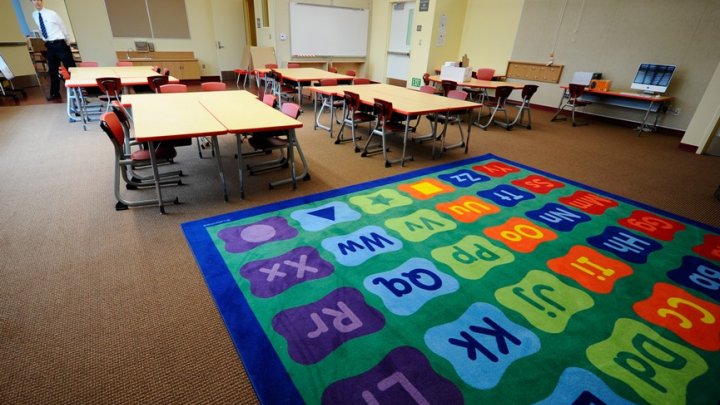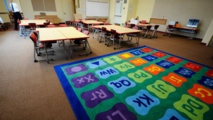It's Thursday morning, and in history class, teacher Blanca Claudio asks her 11- and 12- year old students to find Mesoamerica -- an area stretching from southern Mexico through Central America -- on the map.
Half of the population of Los Angeles -- the second most populous US city after New York -- is of Hispanic origin, and Latinos make up 16 percent of the US population, making them the largest single ethnic minority group in the country.
And even though Spanish is the second most spoken language in the United States and commonly heard in Los Angeles, not even this city has a large bilingual school program.
Most such programs are just designed to serve as a bridge so that foreign students can learn English, and then move on take the mainstream English-language classes.
However, fully bilingual programs -- in which kids take some classes in English and others in another language -- like the one at Franklin are set to expand starting July 1 when a law called Proposition 58 comes into effect.
Although Franklin is called a high school, it also includes a middle school. So it has kids as young as 11.
Passed by 73 percent of voters in a referendum that was held in November, Proposition 58 allows school districts to expand their bilingual education programs if parents so request.
"Under Prop 58, it's about all kids. Parents of monolingual students could take advantage of dual-language programs," said Hilda Maldonado, director of multilingual education for the Los Angeles Unified School District.
"We consider it a win-win approach for all kids to become bilingual."
- 'Parochial' about languages -
There is not a single fully bilingual public school in Los Angles, nor are there any plans right now to open one.
And the bilingual programs that do exist cover few students.
Claudio's sixth grade class, for instance, is part of a plan that benefits 40 of the 1,400 students at Franklin High School, which is 91 percent Latino.
But many of those kids of Hispanic origin do not speak Spanish: the custom of passing it on one from one generation to the next was gradually lost in this country where bilingualism has triggered heated debate.
"The United States has traditionally been very parochial, very provincial, with respect to language learning," said Claude Goldenberg, a professor at the Graduate School of Education at Stanford University.
For a long time, the idea was that classes in America had to be taught in English only. So many Latino immigrant parents sacrificed their language so their children would adapt better to their new country.
Maldonado said many Latinos themselves do not see the advantage of bilingual education, although "second, third, fourth-generation parents have seen the value of bringing back their heritage language."
Goldenberg said that, in general, people are showing more interest in bilingual education, and estimates that the number of bilingual programs in America has gone from 300 to 2,000 in recent years.
There is no consolidated national figure because schools in America are managed at the local level.
"Middle class anglos can see the advantages of their children learning two languages," said Goldenberg.
Besides Spanish, in Los Angeles there are bilingual education programs in Korean, Mandarin Chinese, Arabic and Armenian.
- Traveling the world -
The goal in bilingual programs is for students to learn two languages as their mother tongues.
"It is hard to get used to it but it is fun to learn a different language and different cultures," said Lulu Mykytyn, 11, who has been in a bilingual program for the past year.
She still struggles a bit in Spanish but expressed confidence she will be fluent when she finishes high school.
Another girl, Stella Ferguson, speaks Spanish a bit better. And then there is Colin Smith, whose Spanish is almost perfect and features a nice Mexican accent. He has been in bilingual classes since grade school.
"I do not want to be trapped in just one place. I want to travel all over the world," said Daniela Enamorado, 12, whose family hails from El Salvador.
Under an agreement with an elementary school in the same mainly Latino neighborhood of Highland Park, Franklin expects to take in 20 new students next year to launch its first bilingual ninth grade program.
From sixth to eighth grade -- kids aged 11 to 13 -- students take three classes in Spanish and three in English.
In high school -- grades 9 to 12 and kids aged 14 to 18 -- it is four in English and two in Spanish.
"I do believe in bilingual education," said Franklin principal Regina Marquez Martinez. "This is a vision."
------------------------------------------------------------------------------------------------------------------------
Half of the population of Los Angeles -- the second most populous US city after New York -- is of Hispanic origin, and Latinos make up 16 percent of the US population, making them the largest single ethnic minority group in the country.
And even though Spanish is the second most spoken language in the United States and commonly heard in Los Angeles, not even this city has a large bilingual school program.
Most such programs are just designed to serve as a bridge so that foreign students can learn English, and then move on take the mainstream English-language classes.
However, fully bilingual programs -- in which kids take some classes in English and others in another language -- like the one at Franklin are set to expand starting July 1 when a law called Proposition 58 comes into effect.
Although Franklin is called a high school, it also includes a middle school. So it has kids as young as 11.
Passed by 73 percent of voters in a referendum that was held in November, Proposition 58 allows school districts to expand their bilingual education programs if parents so request.
"Under Prop 58, it's about all kids. Parents of monolingual students could take advantage of dual-language programs," said Hilda Maldonado, director of multilingual education for the Los Angeles Unified School District.
"We consider it a win-win approach for all kids to become bilingual."
- 'Parochial' about languages -
There is not a single fully bilingual public school in Los Angles, nor are there any plans right now to open one.
And the bilingual programs that do exist cover few students.
Claudio's sixth grade class, for instance, is part of a plan that benefits 40 of the 1,400 students at Franklin High School, which is 91 percent Latino.
But many of those kids of Hispanic origin do not speak Spanish: the custom of passing it on one from one generation to the next was gradually lost in this country where bilingualism has triggered heated debate.
"The United States has traditionally been very parochial, very provincial, with respect to language learning," said Claude Goldenberg, a professor at the Graduate School of Education at Stanford University.
For a long time, the idea was that classes in America had to be taught in English only. So many Latino immigrant parents sacrificed their language so their children would adapt better to their new country.
Maldonado said many Latinos themselves do not see the advantage of bilingual education, although "second, third, fourth-generation parents have seen the value of bringing back their heritage language."
Goldenberg said that, in general, people are showing more interest in bilingual education, and estimates that the number of bilingual programs in America has gone from 300 to 2,000 in recent years.
There is no consolidated national figure because schools in America are managed at the local level.
"Middle class anglos can see the advantages of their children learning two languages," said Goldenberg.
Besides Spanish, in Los Angeles there are bilingual education programs in Korean, Mandarin Chinese, Arabic and Armenian.
- Traveling the world -
The goal in bilingual programs is for students to learn two languages as their mother tongues.
"It is hard to get used to it but it is fun to learn a different language and different cultures," said Lulu Mykytyn, 11, who has been in a bilingual program for the past year.
She still struggles a bit in Spanish but expressed confidence she will be fluent when she finishes high school.
Another girl, Stella Ferguson, speaks Spanish a bit better. And then there is Colin Smith, whose Spanish is almost perfect and features a nice Mexican accent. He has been in bilingual classes since grade school.
"I do not want to be trapped in just one place. I want to travel all over the world," said Daniela Enamorado, 12, whose family hails from El Salvador.
Under an agreement with an elementary school in the same mainly Latino neighborhood of Highland Park, Franklin expects to take in 20 new students next year to launch its first bilingual ninth grade program.
From sixth to eighth grade -- kids aged 11 to 13 -- students take three classes in Spanish and three in English.
In high school -- grades 9 to 12 and kids aged 14 to 18 -- it is four in English and two in Spanish.
"I do believe in bilingual education," said Franklin principal Regina Marquez Martinez. "This is a vision."
------------------------------------------------------------------------------------------------------------------------









 Home
Home Politics
Politics











